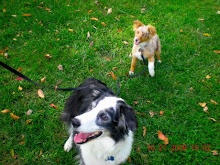Infections of the 4th Premolar (Carnassial Tooth)
Drs. Foster & Smith, Inc.
Race Foster, DVM
If you look inside your dog’s mouth you will notice one tooth that is much larger than the rest. It is on the upper jaw, about half way back. It is the fourth premolar, sometimes referred to as the carnassial tooth (Figure 1). In wild canines, it is the main tooth used to break up or crush hard material in their diet such as bones or large pieces of meat. Today’s canine diets, even the all-dry ones, really do not require this big "work horse" tooth for the animal to adequately break up his food before swallowing. Still, it is there, and it poses some unique problems for the older dog.
Signs and development of a carnassial tooth abscess
An infection of the 4th premolar is a unique dental problem and has outward signs that are often misunderstood by the owner. The large carnassial tooth has three roots, while most other teeth have only 1 or 2. From 1/2" to 3/4" long, they extend from below the gumline up into the bone of the skull just in front of the eye. There are two in the front portion of the tooth and one in the rear. Carnassial tooth infections actually involve only the roots of the tooth and not the visible exposed portion. The individual root usually involved is the front one that is closest to the skin.
Carnassial tooth infections are caused by bacteria that gain access to the root, either by working their way under the gum at the base of the tooth or by being carried there by the bloodstream. Once the bacteria are in this location between the root and the bone of the skull, the body has a very difficult time ridding itself of the infection. Treatment may control the outward signs but when the medication is discontinued, the infection returns.
The bacteria take up residence on the surface of the root and slowly destroy its attachment to the jaw. In doing so, they deprive the root, and therefore, the tooth, of its blood supply. This eventually leads to death of the affected tissue. Dead tissue in the body is treated the same way as a splinter or other foreign material. In an attempt to isolate and repel the material, the body shunts millions of white blood cells into the area to:
Isolate it from the remaining healthy tissue
Dissolve or break it down so that it can be eliminated as typical cellular waste
Expel it whole from the body
This accumulation of white blood cells at the site of an infection or necrotic material is referred to as pus or an abscess.
In the case of a carnassial tooth, the abscess builds up around the affected root just under the skin below and in front of the eye. The swelling may reach the size of a golf ball. In the case of an abscess, the white blood cells and chemicals that are released have the ability to dissolve the body’s tissue. The weakest portion of the body in this case is the skin, so a small pore soon opens from which pus (or a pink-tinged fluid) will drain. Left alone, this opening will occasionally close but then reopen later as more material accumulates.
Owners often confuse this condition with an eye infection, insect bite, or puncture wound. They may consider it something that, if left alone, will heal on its own. The untreated abscess will, in fact, often spread to 1) the eye causing a very serious and potentially blinding infection or 2) other teeth causing them to be lost also. This is fairly painful for the animal, especially when eating. In dogs that stay outdoors or those with long hair, it may remain unnoticed for a long period of time.
Treatment options
Carnassial abscesses are typically seen in older dogs, especially those over seven years of age. By the time we are able to actually recognize a problem, the initially affected root is often dead. Today, veterinary medicine allows the owner to choose between several methods for handling this problem. There was only one option in the past - pull the tooth along with its roots. The tooth is actually split in half so that the roots can be entirely removed. This is the most difficult tooth to remove correctly and if any portion of the root remains, the problem may continue. Veterinarians today can save the tooth with a procedure similar to the 'root canal.' This can be fairly expensive, but it does save the tooth. Either therapy choice is followed by a long-term use of antibiotics to prevent future problems.
When determining which method to use for your animal, keep in mind 1) the cost, 2) the dog’s dental health and overall health, and 3) the effect the loss of the tooth would have on your pet. In most cases, a dog does just fine without this particular tooth and is able to eat any type of food you may choose to give him.
Sunday, March 28, 2010
Subscribe to:
Comments (Atom)









